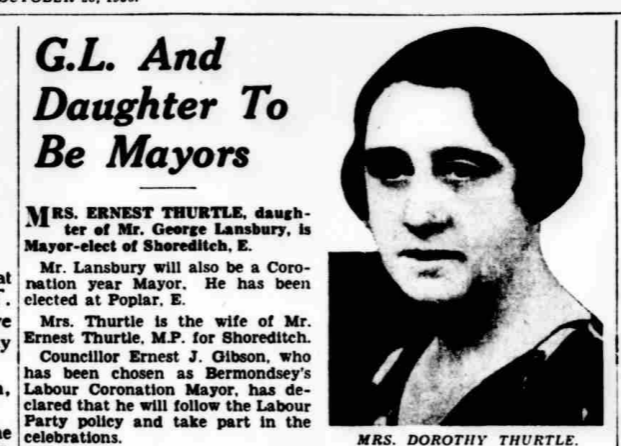Welcome back! We’re continuing our series of revealing research into the history of women at Shoreditch Town Hall, conducted by Jessica Ihejetoh. This time we’re looking at how Shoreditch Town Hall has been a space for positive change amongst the prominent women of East London in the late 1800s and early 1900s. If you missed the introduction to this series, you can find it here.
Helen Taylor
Shoreditch Town Hall has been an important convening space for women to share their ideas, social campaigns and grow political movements. Several prominent feminist writers and activists have passed through Shoreditch Town Hall’s doors, including writer and campaigner Helen Taylor. Born in 1831, Helen was the daughter of women’s right advocate, Harriet Mill, and her stepfather was philosopher and writer, John Stuart Mill. Helen was a passionate campaigner for education, and she joined the London School Board. This organisation was set up to provide universal education to London’s poorest children and allowed women to stand for election on equal terms with men. Its impressive alumni list included Britain’s first female physician Dr. Elizabeth Garrett Anderson and founder of Girton College, Emily Davies.
Helen’s campaign for women’s suffrage brought her to Shoreditch Town Hall in March 1878. She gave a speech petitioning against those who ‘wished to keep women down’. She spoke of the ‘great difference’ the vote would make to ‘growing girls, who would be taught to discuss political questions ’and that ‘it was essential the feminine side of things should be allowed full and free expression’.[2] Helen’s work paved the way for many well-known suffrage campaigners who came after.
Our Sylvia

Sylvia Pankhurst born in 1882, was the daughter of suffragette Emmeline Pankhurst. Her childhood home included visits from figures like Keir Hardie, founder of the Labour Party and the designer William Morris. Sylvia worked with her mother and elder sister Christabel, campaigning for women’s voting rights. She established the Bow branch of the Women’s Social & Political Union (WSPU) and organised rallies across London. The eighth demonstration at Shoreditch Town Hall saw her finally ‘seized by police’[3], arrested, and imprisoned. However, Sylvia’s long career of campaigning for women in East London continued.
Following the split with the WSPU, Sylvia formed the East London Federation of Suffragettes in 1914. This group focused on improving the conditions of working-class women and universal suffrage for all. She developed a volunteer-led mother and baby clinic in East London. She also established ‘cost price’ canteens, offering affordable meals aimed at tackling food shortages and inflation in World War I. Finally, she also developed the East London Toy Factory, which employed local working-class women and paid them a fair wage. The combined campaigning efforts of the suffragists meant women aged 21 and over finally gained the right to vote on equal terms with men in 1928.
Women Mayors: Henrietta Girling and Dorothy Thurtle

Walking through Shoreditch Town Hall there is evidence of women’s political voices. An engraved bronze plaque shows early female mayors who helped shape policy in East London. One such figure was Henrietta Girling OBE, who became Shoreditch’s first woman mayor in 1930. She had joined the council in 1919 and supported ‘pioneer work’ in the Maternity and Child Welfare Centre which opened in 1923[6].
Following in her footsteps, Dorothy Thurtle became Mayor of Shoreditch in 1936. She was born in East London in 1890 and was the sixth child of Labour MP George Lansbury. Dorothy was elected to a council seat in a by-election in December 1925, and by 1936 had become Mayor of Shoreditch. Much of her career focused on women’s reproductive rights and Dorothy founded the Worker’s Birth Control Group. This organisation campaigned for working-class women’s access to healthcare and advice on family planning.
However, the East End also has a long tradition of working-class women paving the way for their own improved conditions. ‘The Matchgirl Strikes’ of 1888 saw women and girls lead a mass strike for improved terms, pay and conditions at the Bryant and May Factory in Bow. Numerous incidents of industrial action involving women ropemakers, garment makers, factory workers and more reached Shoreditch Town Hall. There have been demonstrations over inflated bread prices, ‘women hunger marchers’ and countless protests about poor housing. In one such protest in 1947 women and children march to Shoreditch Town Hall to protest against unsafe living conditions and errant landlords on their road in Hoxton, which they labelled ‘Misery Street’[7].
[1] J S Mill and H Taylor – Helen Taylor (feminist) – Wikipedia
[2] Women’s Suffrage Journal, March 1879, Volume IX, January to December 1878, p44 [1]
[3] London Evening Standard, Wednesday 10 December 1913. © British Library Board. All Rights Reserved.
[4] Sylvia Pankhurst, Circa 1930. Image © Keystone-France/Gamma-Keystine via Getty Images.
[5] Daily Herald – Wednesday 28 October 1936 Image © Reach PLC. Image created courtesy of THE BRITISH LIBRARY BOARD.
[6] Vote – Friday 23 January 1931 Image © Successor rightsholder unknown. .. Image created courtesy of THE BRITISH LIBRARY BOARD.
[7] The People – Sunday 02 March 1947. Image © Reach PLC. Image created courtesy of THE BRITISH LIBRARY BOARD

